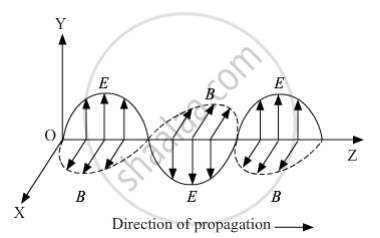Advertisements
Advertisements
प्रश्न
Write Maxwell's generalization of Ampere's circuital law. Show that in the process of charging a capacitor, the current produced within the plates of the capacitor is `I=varepsilon_0 (dphi_E)/dt,`where ΦE is the electric flux produced during charging of the capacitor plates.
उत्तर
A moving charge produces both electric and magnetic fields, and an oscillating charge produces oscillating magnetic and electric fields. These oscillating electric and magnetic fields with respect to space and time produce electromagnetic waves.
The propagation of electromagnetic waves can be shown as

OR
Maxwell's generalisation of Ampere's circuital law is given as follows:
`oint vec"B".vec"dl"=mu_0(I+I_D)=mu_0(I+varepsilon_0 (dphi)/dt)`
Consider that a parallel capacitor C is charging in a circuit.
The magnitude of electric field between the two plates will be `E=q/(varepsilon_0 A)`and is perpendicular to the surface of the plate.
`phi_E=vecE.vecA=EA cos0=q/(varepsilon_0 A)xxA=q/varepsilon_0`
`=>(dphi_E)/dt=(d(q/varepsilon_0))/dt`
`=>(dq)/dt=varepsilon_0(dphi_E)/dt ("Here, dq/dt is rate of change of charge with time.")`
`=>I=varepsilon_0(dphi_E)/dt`
APPEARS IN
संबंधित प्रश्न
State Ampere’s circuital law.
A 3.0 cm wire carrying a current of 10 A is placed inside a solenoid perpendicular to its axis. The magnetic field inside the solenoid is given to be 0.27 T. What is the magnetic force on the wire?
A long, straight wire carries a current. Is Ampere's law valid for a loop that does not enclose the wire, or that encloses the wire but is not circular?
A thin but long, hollow, cylindrical tube of radius r carries i along its length. Find the magnitude of the magnetic field at a distance r/2 from the surface (a) inside the tube (b) outside the tube.
A long, cylindrical tube of inner and outer radii a and b carries a current i distributed uniformly over its cross section. Find the magnitude of the magnitude filed at a point (a) just inside the tube (b) just outside the tube.
Two identical current carrying coaxial loops, carry current I in opposite sense. A simple amperian loop passes through both of them once. Calling the loop as C, then which statement is correct?
Using Ampere’s circuital law, obtain an expression for magnetic flux density ‘B’ at a point near an infinitely long and straight conductor, carrying a current I.
When current flowing through a solenoid decreases from 5A to 0 in 20 milliseconds, an emf of 500V is induced in it.
- What is this phenomenon called?
- Calculate coefficient of self-inductance of the solenoid.
